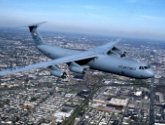
 The C-141 Starlifter is the workhorse
of the Air Mobility Command. The Starlifter fulfills the vast
spectrum of airlift requirements through its ability to airlift
combat forces over long distances, inject those forces and their
equipment either by airland or airdrop, re-supply employed forces,
and extract the sick and wounded from the hostile area to advanced
medical facilities.
The C-141 Starlifter is the workhorse
of the Air Mobility Command. The Starlifter fulfills the vast
spectrum of airlift requirements through its ability to airlift
combat forces over long distances, inject those forces and their
equipment either by airland or airdrop, re-supply employed forces,
and extract the sick and wounded from the hostile area to advanced
medical facilities.
The C-141B is a stretched C-141A with in-flight refueling capability. Stretching of the Starlifter consisted of lengthening the plane 23 feet, 4 inches (53.3 centimeters), which increased cargo capacity by about one-third - 2,171 extra cubic feet (65.13 extra cubic meters). Lengthening of the aircraft had the same effect as increasing the number of aircraft by 30 percent. The C-141 was the first jet aircraft designed to meet military standards as a troop and cargo carrier.
A universal air refueling receptacle on the C-141B transfers
23,592 gallons (89,649.6 liters) of fuel in about 26 minutes,
allowing longer non-stop flights and fewer fuel stops during
worldwide airlift missions. The C-141 force, nearing seven million
flying hours, has a proven reliability and long-range capability.
The Starlifter, operated by the Air Mobility Command, can airlift
combat forces, equipment and supplies, and deliver them on the
ground or by airdrop, using paratroop doors on each side and
a rear loading ramp. It can be used for low-altitude delivery
of paratroops and equipment, and high-altitude delivery of paratroops.
It can also airdrop equipment and supplies using the container
delivery system. It is the first aircraft designed to be compatible
with the 463L Material Handling System, which permits off-loading
68,000 pounds (30,600 kilograms) of cargo, refueling and reloading
a full load, all in less than an hour.
The C-141 has an all-weather landing system, pressurized cabin
and crew station. Its cargo compartment can easily be modified
to perform around 30 different missions. About 200 troops or
155 fully equipped paratroops can sit in canvas side-facing seats,
or 166 troops in rear-facing airline seats. Rollers in the aircraft
floor allow quick and easy cargo pallet loading. A palletized
lavatory and galley can be installed quickly to accommodate passengers,
and when palletized cargo is not being carried, the rollers can
be turned over to leave a smooth, flat surface for loading vehicles.
In its aeromedical evacuation role, the Starlifter can carry
about 103 litter patients, 113 ambulatory patients or a combination
of the two. It provides rapid transfer of the sick and wounded
from remote areas overseas to hospitals in the United States.
The Air Force Reserve, through its associate units, provides
50 percent of the Starlifter's airlift crews, 40 percent of its
maintenance capability and flies more than 30 percent of Air
Mobility Command's peacetime worldwide missions.
The first Air National Guard and Air Force Reserve units to receive
the C-141 as unit equipment became operational in fiscal 1987.
The units are located at Jackson, Miss., and Andrews Air Force
Base, Md.
During Desert Shield and Desert Storm, a C-141 from the 437th
Military Airlift Wing, Charleston AFB, S.C., was the first American
aircraft into Saudi Arabia, transporting an Airlift Control Element
from the 438th Military Airlift Wing, McGuire Air Force Base,
N.J. In the following year, the C-141 completed the most airlift
missions - 7,047 out of 15,800 - supporting the Gulf War. It
also carried more than 41,400 passengers and 139,600 tons (125,690
metric tons) of cargo.
Background
The first C-141A, delivered to Tinker AFB, Okla., in October
1964, began squadron operations in April 1965. Soon, Starlifters
made flights almost daily to Southeast Asia, carrying troops,
equipment and supplies, and returning patients to U.S. hospitals.
Several C-141s have been modified to carry the Minuteman intercontinental
ballistic missile in its special container, up to a total weight
of 92,000 pounds (41,400 kilograms). Some C-141s have been equipped
with intraformation positioning sets that enable a flight of
two to 36 aircraft to maintain formation regardless of visibility.
The C-141 was the first jet transport from which U.S. Army paratroopers
jumped, and the first to land in the Antarctic. A C-141 established
a world record for heavy cargo drops of 70,195 pounds (31,587.7
kilograms).
The first C-141B was received by the Air Force in December 1979.
Conversion of 270 C-141s from A to B models was completed in
1982.
Nation of Orgin: USA
Constructor: Lockheed-Georgia Co
Primary Function: Long-range troop and cargo airlift
Power Plant: Four Pratt & Whitney TF33-P-7 turbofan engines
Thrust: 20,250 pounds (9,112.5 kilograms), each engine
Length: 168 feet, 4 inches (51 meters)
Height: 39 feet, 3 inches (11.9 meters)
Wingspan: 160 feet (48.5 meters)
Ceiling: 41,000 feet (12,424 meters)
Maximum Takeoff Weight: 323,100 pounds (145,395 kilograms)
Speed: 500 mph (Mach 0.66)
Range: 2,500 miles (2,174 nautical miles)
Unit Cost: $8.1 million (1992 dollars)
Crew: Six (pilot, co-pilot, two loadmasters, and two flight engineers)
Date Deployed: C-141A: May 1964; C-141B: December 1979